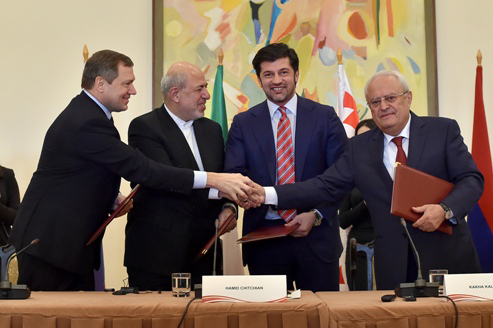Armenia, Iran, Georgia, Russia Agree to Work on Interlinked Power Transmission System

From left to right: Chief executive of Russia’s power distribution grids company, Rosseti, Oleg Budargin; Iran’s Energy Minister Hamid Chitchian; Georgia’s Energy Minister Kakha Kaladze, and Armenia’s Energy Minister Yervand Zakharyan seen after signing of memorandum in Yerevan on December 23, 2015. Photo: Armenian Energy Ministry
Armenia, Iran, Georgia and Russia have agreed to work on development of power transmission system to foster electricity trading between the four countries.
Armenian Energy Minister Yervand Zakharyan, his Georgian and Iranian counterparts Kakha Kaladze and Hamid Chitchian, respectively, as well as chief executive of Russia’s power distribution grids company, Rosseti, Oleg Budargin, met in Yerevan on December 23.
A joint memorandum was signed to cooperate in studying technical and legal framework for possible synchronous operation of the four countries’ electricity transmission systems.
While the electricity systems of Iran and Armenia, as well as of Russia and Georgia, are capable of synchronous operation, no such capabilities are currently in place when it comes to all four countries together, according to Russia’s power grids operator Rosseti.
Rosseti CEO Oleg Budargin said that “energy corridor, Russia-Georgia-Armenia-Iran, will be a strategic route for transmission of electricity between the participating states”, and implementation of the signed memorandum will be “yet another step for development of integration processes.”
“I think we should make maximum use of our country’s geopolitical location, including in terms of [region-wide] electricity trading,” Georgian Energy Minister Kakha Kaladze said on December 23.
“We have possibility, especially during the spring-summer period, when we have surplus of electricity, to export it to Iran; in that same period demand for electricity is high on the Iranian market and we will be able to export electricity not only to Turkey, but also to Iran via Armenia. We will also have possibility to import electricity from Iran during the winter period, when electricity consumption is high in Georgia and when we have deficit in electricity,” Kaladze added.
Armenian Energy Minister Yervand Zakharyan said that planned 400 kV power transmission line, combined with synchronous operation of power systems of the four countries will contribute to regional cross-border electricity trading.
“It will give us the capacity to transmit 1,000-1,200 megawatt electricity from South to North – Iran, Armenia, Georgia and Russia, and vice versa from North to South. It will also provide for synchronous and parallel operation of electricity systems of these states,” Zakharyan said.
Speaking at the 26th Meeting of the Energy Charter Conference, held in Tbilisi on December 3-4, Energy Minister Kaladze said that Georgia is “considered to be in forefront of fostering” regional energy cooperation.
“Our goal is to strengthen regional cooperation through electricity trading, as well as through contributing political dialogue and developing transportation routes,” Kaladze said.
In this context he noted importance of the Black Sea Energy Transmission Line, running between the east and west of Georgia and connecting to the north-east of Turkey, which was implemented with investments from the EBRD, the European Investment Bank (EIB) and the German development bank KfW.
“This is one of the most significant infrastructure projects in the energy sector, which links Georgian and Turkish electricity systems with the capacity of 700 megawatts,” Kaladze said at the Meeting of the Energy Charter Conference in Tbilisi in early December.
“Logical continuation of this project involves having a similar interconnection with Russia, Azerbaijan and Armenia, which is very important for our country, as well as for our neighbors and Europe,” he added.
According to the Georgian National Energy Regulatory Commission, total capacity of Georgia’s cross-border power transmission stood at 2,230 megawatts as of end-2014; according to the commission’s annual report covering 2014, implementation of planned infrastructure projects will increase the capacity to 5,770 megawatts by 2020.
This post is also available in: ქართული (Georgian) Русский (Russian)